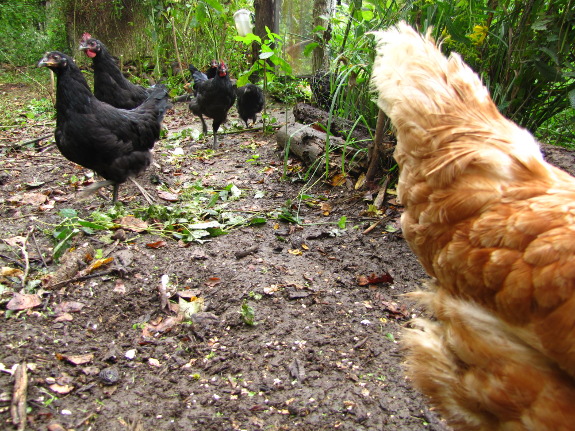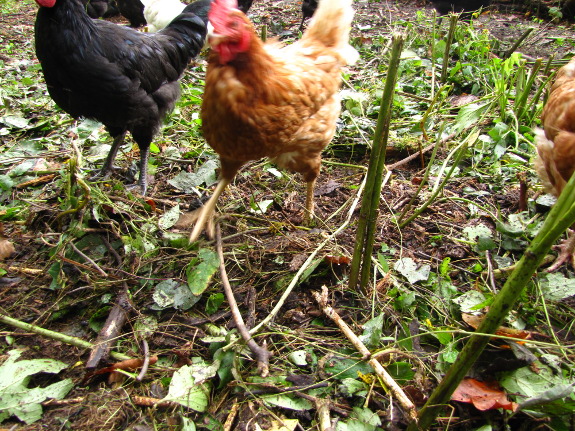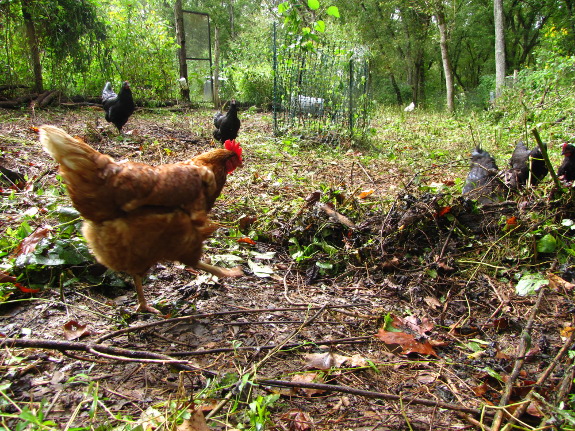
Clearing new ground with animals

A bit over a day after
turning our flock into the
pasture we're renovating, they've already made quite
an impact. The photo above is the pasture's compost pile, so it
wasn't very weedy to begin with, but I can see bare ground in several
other locations as well.

I figure the annual
weeds (most notably ragweed) will be wiped out by our weedwhacking,
followed by a heavy round of chicken scratching, and then planting a
winter crop. The perennials will have to be cut several more
times next year before they'll give up the ghost, though.
My friend Megan not only
sells amazing
pastured meat, she
is also an experienced keeper of dairy goats, sheep, cows, pigs,
chickens, and just about any other type of farm livestock you can think
of. I picked her brains about our idea of adding miniature
goats or sheep to
our menagerie for weed control in the chicken pasture, and she had some
great local advice. She hasn't worked with miniature animals, but
reports that full-size sheep really aren't going to cut it on our rough
pastures, and that goats will be hard workers but absolutely refuse to
eat wingstem. Drat! Wingstem is one of our most common
perennial weeds.

Megan seconded one of
our reader's suggestions of running goats on new
ground using four cattle panels to make a relatively easy to move but
heavy duty goat "tractor." Her goats love Japanese honeysuckle
and will eat it down to the ground, but of course the vines will
regrow. She actually thinks we should get a pig and let it root
out all of the perennials at once then turn it into bacon, but I'm a
bit scared of that idea. I'm okay with slow and steady progress,
and our hens are definitely making headway.
Want more in-depth information? Browse through our books.
Or explore more posts by date or by subject.
About us: Anna Hess and Mark Hamilton spent over a decade living self-sufficiently in the mountains of Virginia before moving north to start over from scratch in the foothills of Ohio. They've experimented with permaculture, no-till gardening, trailersteading, home-based microbusinesses and much more, writing about their adventures in both blogs and books.
Want to be notified when new comments are posted on this page? Click on the RSS button after you add a comment to subscribe to the comment feed, or simply check the box beside "email replies to me" while writing your comment.

I suppose I'd always assumed that you guys had considered the multi-animal rotational system and that you weren't doing it yet because you have to take it in stages. I believe it is most advocated by Polyface farms, using it as a sustainable practice for their animals and their land. First the cattle (or whatever grazers you like, sheep or goats would apply in your case), they mow. Follow them with chickens to scratch the biomass in and strip the grounds of excess weed seeds, etc. They are then followed by pigs to dig up and turn over the soil, integrating the biomass even deeper as well as plowing. Followed then by a season of lying fallow before starting the cycle all over again. It's a system that I always planned on following on my own land once I got that far, since it's sustainable and very healthy for both soil and animals. It could also be an excellent way to prepare a new space for planting if you have the patience of a year-ish to let it take place naturally.
I don't know if, as I assumed, this was already something you planned to work toward, but I love the idea of a four-pasture system rotation like this. Each animal does something different to the field in the wake of the previous livestock and are therefore not impacting the space too much in one particular resource. Seems very harmonious to me.
Heather --- That's nice of you to say, but I don't think we're enough bee experts to write a book about them! I do plan to include a basic primer on introductory bee care in a late volume of Weekend Homesteader, but I suspect it'll be several more years before I consider myself enough of a beekeeping expert to write a whole book about them.
Brandy --- I've always loved the elegance of Joel Salatin's multi-animal rotation, but it just doesn't make sense on our farm because of scaling issues. He's raising animals to sell for meat and has acres of pasture, whereas we're just raising enough for us and have only tiny little bits of pasture. So we're trying to come up with a system that's nearly as elegant as his, but which works on the small scale. That means using the minimum number of animals and using small animals rather than full-size livestock if at all possible. Maybe in a decade or two, I'll have a system that other homesteaders can follow like Joel Salatin has a system that large scale producers can follow.
Well, I think you have to consider the acreage needed for each animal and how much they compete with each other. For example, I'd estimate that two miniature goats and a kid would require at least a quarter of an acre of pasture, which is about what we need for our chickens. The two types of animals only barely compete with each other, so I could probably have a quarter of an acre for both. If I added in pigs, I'd need at least half an acre just for one, and then, like you said, there would be quite an extended rotation while renovating the soil to go back to grazers. So, for miniature goats, chickens, and one pig, I'd probably need at least an acre or so.
I'll definitely keep you posted as we experiment with smaller scale rotations. It's one of my favorite puzzles.